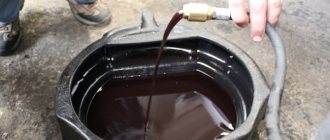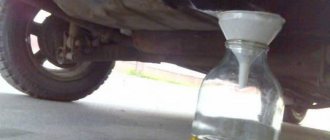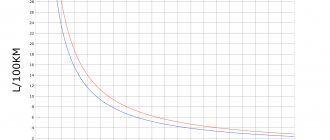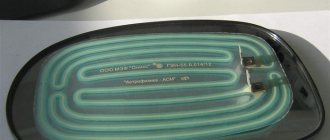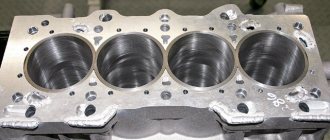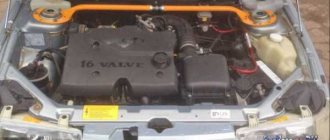Will the oil pressure increase?
If anyone doesn’t know, I’ll explain: the fuel pump has no bearings at all. It works by friction, and gasoline acts as a lubricant. Well, it's the same as it was before. Now, they are striving to make gasoline absolutely pure. It contains no resins or additives that could soften friction. So it turns out that if you add a small amount of oil to the tank, the rubbing parts will be better lubricated.
On “mixed” fuel, the fuel pump is much quieter and, in addition, increases the fuel pressure in the line. Thus, oil only has a positive effect on the operation of the fuel pump.
Reasons why there is gasoline in oil
There are many reasons why gasoline got into the oil, including they depend on the type of engine fuel system (carburetor, injection, direct injection). Let's look at them in order, and start with the injection gasoline engine:
- Use of low-quality fuel . It can damage seals, through which fuel will leak into the engine over time. In addition, the air-fuel mixture created from it can damage the surfaces of cylinders, pistons, and valves.
- Use of low-quality additives . Poor quality fuel additives can damage sealing gaskets. Therefore, you need to approach their use with an understanding of the matter and choose the right one or another.
- Worn cylinder piston rings and weak compression . This usually happens for natural reasons as a result of prolonged use of the car, or due to mechanical damage. For this reason, the fuel goes directly into the crankcase, where it mixes with the engine oil.
- Faulty EGR system . Improper operation of the exhaust gas recirculation system can also cause gasoline to enter the oil.
- The injectors are leaking . On engines with direct fuel injection (eg TSI), if the injectors are leaking, a small amount of gasoline will seep into the engine oil when the engine is started. So, after parking with the ignition on (when the pump creates a pressure of up to 130 bar), the pressure in the fuel rail ensures that gasoline enters the combustion chamber, and through the gap in the rings into the oil. A similar problem (albeit to a lesser extent) can occur in ordinary injection engines.
- Faulty fuel vacuum regulator . If it does not operate correctly, part of the fuel returns to the engine and mixes with the oil through the gaps.
- Rich air/fuel mixture . The formation of a rich mixture can be caused by various reasons. On injection engines this is due to a malfunction of sensors or injectors, while on carburetor cars the carburetor may simply be incorrectly configured.
- Faulty ignition coil/plug/high voltage wires . The result of this is the fact that the air-fuel mixture in a particular cylinder does not burn. The air naturally evaporates, and fuel vapor remains on the cylinder walls, from where it enters the crankcase.
Let us consider separately the reasons for carburetor engines:
- Damage to the fuel pump diaphragm . This can happen due to natural causes (aging and wear) or as a result of mechanical damage. The lower part of the diaphragm is designed to protect its upper part from harmful crankcase gases. Accordingly, if one layer or another is damaged, a situation may arise when gasoline leaks into the crankcase, mixing there with the lubricant.
- Problems with the needle valve . Over time, it can also become damaged and not work properly, leaking gasoline.
- Incorrect carburetor setting . As a result, gasoline may overflow into the carburetor, including the formation of an enriched air-fuel mixture. And if the diaphragm is damaged, the situation only gets worse.
Are there any downsides?
Yes, they are. Although, this is one big minus that outweighs all the pluses. Mixed with fuel, the liquid enters the engine. And there, when exposed to high temperatures, carbon deposits begin to accumulate. Almost everything suffers, pistons, sensors, and the manifold itself.
Even if you just try to drive on such fuel, there will be quite a lot of soot. What if you constantly add oil? In this case, get ready for the engine to fail soon. First, there will be a loss of power, then the car will start hard, and then it will become a “dead weight.”
How to tell if there is gasoline in the oil (signs)
There are ten main signs that indicate that there is gasoline in the engine oil.
- The oil smells like gasoline . This is usually clearly felt when checking the lubricant level in the crankcase. You can smell both the dipstick and the filler hole. The smell is especially noticeable when the engine is warm. Often the smell does not have a gasoline, but an acetone tint.
- The oil level gradually rises even though it has not been added to the crankcase. This usually does not happen abruptly, but gradually as the vehicle is used over the long term.
- An increase in fuel (gasoline) consumption parallels an increase in oil level.
- The oil becomes more liquid . That is, it loses viscosity. This can be determined simply by touch, by testing the composition with your fingers on the probe. Or simply see that oil has begun to drain easily from the dipstick, although this has not been observed before.
- Reduced oil pressure . Moreover, this fact may be accompanied by a simultaneous increase in its level in the crankcase. This is explained by its dilution (especially important for viscous oils).
- Difficulty starting the engine “hot” . This is due to the loss of viscosity by the oil.
- Decrease in engine power . This is expressed in a decrease in dynamic characteristics, as well as a loss of traction (the car accelerates poorly and does not pull uphill). Due to increased friction between the parts of the crankshaft.
- Spontaneous increase in engine speed at idle . Typical for injection engines.
- Errors appearing in the ECU memory . In particular, they are associated with the formation of an enriched air-fuel mixture, misfires, as well as malfunctions of the lambda probe (oxygen sensor).
- Exhaust gases acquire a sharper, fuel-like odor . Sometimes at the same time they acquire a darker shade.
Please note that the last three signs may indicate other problems with the car’s engine, so it is advisable to carry out a full diagnosis, primarily through the use of diagnostic scanners. The problem with fuel getting into the oil also occurs in diesel power units, however, and it is determined by the same signs, but the reasons for these two types of engines will be different.
Malfunctions and checking of injectors of the injection power system
To understand why gasoline is in engine oil, it is necessary to look at the design features of various internal combustion engines.
- First of all, on any engine (injector, carburetor), fuel enters the crankcase from the combustion chamber through the piston rings. It is important to understand that if you pour gasoline into the cylinders of a new engine, after some time it will end up in the oil. The reason is simple - the fuel washes away the oil film and passes through the leaks at the locations of the piston rings.
- For engines with a carburetor, a common cause of gasoline getting into the oil is damage to the fuel pump diaphragm. Another reason for oil dilution with fuel is problems with the carburetor needle valve in the float chamber, fuel overflow into the carburetor, etc.
In other words, fuel may be supplied in excess, but the rich mixture will not ignite. Also, gasoline does not burn because there is no spark at the spark plug or the charge does not burn due to low compression in the internal combustion engine. In any case, unburned fuel enters the crankcase.
If the carburetor “poured” gasoline into the float chamber or “poured” the injection nozzles, then the fuel will also flow into the cylinders and then enter the oil. In order to prevent fuel from getting into the oil in one way or another on the injector, you need to check the tightness of the injection nozzles and clean them.
It is also recommended to carry out computer diagnostics of the engine, evaluate the quality of mixture formation, and separately “call” the ECM sensors, which can affect the formation of the mixture. On carburetor internal combustion engines, the condition of the fuel pump diaphragms is monitored, and the carburetor is regularly adjusted and diagnosed.
Before a cold start (especially in winter), you need to periodically ensure that no running gasoline appears or accumulates under the carburetor. If such a phenomenon is noticed, then the carburetor should be checked.
Taking into account the fact that the fuel supply system on different engines can be very different, the ways in which gasoline enters the lubrication system also differ. On engines with fuel injection, gasoline is supplied from the fuel tank under pressure created by an electric fuel pump. At this stage, the oil cannot mix with the fuel.
- At the same time, a mechanical fuel pump is installed on carburetor engines. The diaphragm of such a pump forces gasoline into the carburetor installed on the engine. The mechanical pump rod on some cars is driven by an eccentric and is also lubricated with engine oil in the same way as the camshaft.
If the pump diaphragm is damaged, gasoline begins to enter the rod channel, penetrating the lubrication system. When the membrane is not severely damaged, then the accumulation of gasoline in the oil will occur slowly, and the lubrication level will not increase. The problem is indicated by a change in the smell of the oil, as well as some dilution.
In the case when the membrane has large breaks, gasoline stops flowing into the carburetor, the internal combustion engine starts with difficulty, jerks and dips appear when moving, the unit operates unstable, etc. To eliminate the malfunction, you need to replace the fuel pump membrane, as well as the engine oil.
- On the injector, most problems are related to the injectors, since an experienced driver can immediately detect malfunctions in the ignition. A more complex situation is when one or more injectors cannot close tightly. This means that after stopping the engine, the fuel, which is in the fuel rail under residual pressure, flows into the manifold, then enters the cylinders, and then flows into the crankcase.
Piston rings to some extent prevent gasoline from falling into the oil, but if they are worn out or stuck, then fuel flows relatively freely into the oil pan. To solve the problem, you need to remove the fuel rail, after which the tightness of each injection nozzle is checked.
To do this, flushing liquid or kerosene is supplied to the injector under pressure, and the opening and closing of the nozzle is initiated from the power source. You can also use a special stand to check and clean the injectors. If the injectors are leaking, then they need to be repaired or replaced.
- As for the ignition system, if the mixture does not ignite in one of the cylinders or in several, then part of the fuel flies out into the exhaust system, and the remaining parts simply settle on the cylinder walls, then flow into the engine crankcase.
Malfunctions of the ignition system are diagnosed as usual. First, the spark plugs are checked, then the high-voltage armored wires, coil, distributor and other elements that are installed on a particular vehicle.
- CPG wear is a common problem with carburetor and injection internal combustion engines. As a rule, we are talking about wear of compression and oil scraper rings. In such a situation, fuel actively flows into the crankcase. It is important to consider that problems with rings also lead to decreased compression.
It turns out that the mixture compresses worse and burns incompletely, the engine loses power. The driver presses the gas harder, supplying more fuel to the combustion chamber, but combustion does not occur in full. Excess fuel leads to engine contamination and the formation of carbon deposits, and also partially enters the crankcase.
Tell me, can fuel get into the oil?
If it is still gasoline, then for some reason it does not evaporate - most likely the crankcase gas suction channel in the engine head cover is clogged, this can be easily checked. Gasoline can easily get into the oil, for example, if the injector does not hold pressure, then after turning off the engine, the next portion will be released into the intake manifold (until the pressure drops), then into the cylinder and between the oil scraper rings into the pan.
that I know how all the crankcase ventilation tubes go to the RP and whether there is a starting injector. But if they have contact with each other then this is a possible way.
The RP does not have a starting injector. I checked the channel through the crankcase ventilation tube.
: According to the description, the power and lubrication systems really do not fit anywhere close to each other, except in the combustion chamber. : I checked the spark plugs - everything is in excellent condition. : Spark - present in all 4 cylinders. : That’s why I’m racking my brains. ===== This doesn't happen. I would attribute everything to a miracle, but, as everyone convinces me, miracles do not happen. Other than one bad cylinder, I see no explanation. Are there any signs of this? For example, one candle is always wet. Or colder than others. How did you check the spark? What if you remove the I/O wires one by one (but first you need to find out if this can be done on this engine, I’m not sure about that)?
Checking and repairing a mechanical fuel pump at home
It is advisable to begin any repair work on the engine by washing and cleaning dirt and dust at least at the repair site. The fuel pump must be removed by unscrewing the two mounting bolts. It is better not to disconnect the inlet and outlet gas pipelines if they do not interfere with dismantling. Otherwise, they can be disconnected by plugging the incoming fuel line with a plug of the appropriate size, otherwise fuel will leak from it.
After removal, put the fuel lines onto the fittings and secure them with clamps. The outgoing gas line must be clamped with a clamp if it is rubber. If the tube is metal, disconnect it from the carburetor and plug it tightly with a suitable plug. Then try to pump gasoline into the engine using the manual pumping lever.
Further actions are possible in two options: replace the fuel pump with a similar new one or repair the existing one. When repairing an already installed device, you must purchase a repair kit for the device model being repaired. As a temporary option, you can add a couple of layers of cellophane to the diaphragm, but this will not last long. Disassembly and assembly of the fuel pump must be carried out in accordance with the vehicle manual.
If you have a set of spare parts for repair, it is advisable to replace all existing parts, especially the intake and exhaust valves and their springs. Wash the filter mesh thoroughly in clean gasoline or solvent. After assembly, it is advisable to check the functionality of the device and the tightness of the diaphragm. Checking this part is described above.
You can check its functionality by disconnecting the outgoing gas line from the carburetor or pump and pumping it with a lever. A full stream of fuel should splash out of the hose or fitting with each press. After completing all repair work, you need to more carefully monitor the oil, its level and color for some time during operation to be completely sure that the problem has been eliminated.
If one or more injectors do not close completely, fuel may leak into the cylinder and through the piston clearances into the oil. First, you can check the pressure in the power system. To do this, you need to get a pressure gauge with a rubber hose for high pressure and an adapter for connecting to the fuel rail. The upper limit of the pressure measured by the pressure gauge must be at least 6 kgf/cm².
The adapter must be connected to the ramp, the pressure gauge must be connected to the adapter. Then you need to turn on the ignition. If the fuel pump starts, wait until normal pressure rises in the rail. Then turn off the ignition. If the fuel pump does not start when the ignition is turned on (this is not a malfunction), start the engine, check that the pressure rises to the nominal value, turn off the engine and turn off the ignition.
You need to observe the pressure gauge readings for 5-10 minutes. If the instrument needle has moved downward by more than a third (example: the nominal pressure was 3 kgf/cm², after stopping it dropped to 2 kgf/cm²), you should look for a leak in the fuel supply system. Next, you need to remove the fuel rail with injectors and place it in a place accessible for inspection.
Injectors that are not completely closed can cause fuel to enter the lubricant.
Each of the nozzles should be placed in a transparent container; you can use plastic glasses with a volume of 0.5 liters. Fuel lines and electrical connections must be connected. Then you also need to turn on the ignition and, if necessary, crank the engine with the starter.
While scrolling, you can visually check the operation of the injectors by the type of fuel being sprayed. Having reached the optimal pressure in the power system, you need to turn off the ignition and visually check each of the injectors for gasoline leakage through the nozzle. If you detect leakage on one or more injectors, you can measure the resistance of the windings with a tester.
How to determine gasoline in oil
Any car owner can determine whether there is gasoline in the oil during a standard procedure in the morning before starting the engine. You can do this using one of the methods below.
Check the smell
The simplest method of checking to find out the gasoline in the oil is to smell the oil when checking the level with a dipstick or when unscrewing the oil filler cap. If the engine oil smells like gasoline, this should alert you and force you to perform several other checks. Please note that the oil may smell not like gasoline, but like acetone . This depends on the quality of the gasoline and oil used, the condition of the lubricant and other reasons.
Drip test
Often, as the smell of the oil changes, it becomes more liquid, that is, it begins to flow easily from the dipstick. You also need to pay attention to this, especially if the oil was filled quite a long time ago, for example, the mileage on it is already more than halfway through its service life. Therefore, in addition to smelling the lubricant, conduct a drop test to determine the quality of the oil.
So, to perform it, you just need to drop a few grams of the test lubricant onto plain paper. You will not get an immediate answer, since you need to leave it in a warm place for at least a couple of hours (preferably 12). But, having analyzed the spreading zones (at the edges of the circle there will be a sector that has a yellowish or reddish tint), then with a high degree of probability gasoline gets into the oil or not.
And in order to reduce the erroneous suspicion to zero, it is worth paying more attention to the signs discussed above and checking for combustion.
Engine oil burning
Many experienced car enthusiasts, in order to find out if there is gasoline in the oil, simply ignite the lubricant. Inexperienced drivers who have never encountered such a problem often mistakenly try to simply set fire to the oil directly on the dipstick. This approach will not give results, unless there is already a critical part of gasoline in the oil, but this happens rarely, and it will be visible from other, obvious signs.
In fact, it is necessary to set fire to the oil heated in the test tube . So, to do this you need to take a glass test tube with a narrow neck and pour a small amount of oil into it. If the test tube has a flat bottom, then it is better to heat it on an electric stove. If the test tube has a rounded bottom, then you can take it in laboratory tongs and heat it on an open fire source (stove, candle, dry alcohol, etc.). Please note that during the heating process, the neck (upper part) of the test tube must be tightly closed with some kind of lid so that the gasoline does not evaporate during the heating process.
The essence of the problem
In a healthy engine, the lubrication system in which oil circulates is isolated from the fuel system. As a result, gasoline cannot penetrate the oil. However, if this happens, the oil dipstick will emit a gasoline smell (the oil smells like gasoline).
If the driver does not trust his sense of smell, then the presence of gasoline on the dipstick is determined quite simply. To do this, you need to move a sufficient distance away from the car and apply an open flame to the dipstick using a lit match or lighter. The presence of gasoline is indicated by a flash, while pure oil will ignite very slowly.
